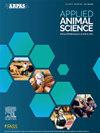Bile salt inclusion rates in milk replacer fed to neonatal calves
IF 1.5
Q3 AGRICULTURE, DAIRY & ANIMAL SCIENCE
引用次数: 0
Abstract
Objective
The objective was to evaluate bile salts (BS) at increasing inclusion rates to determine the opti- mal inclusion rate for increasing neonatal calf fat digestion and absorption for improved growth performance.
Materials and Methods
Eighty 2-to-5-d-old Holstein bull calves were blocked by BW and randomly assigned to one of 4 treatments using a randomized complete block design. Treatments of (1) BS0: control, no BS added to milk replacer (MR); (2) BS1/2: BS (poultry bile, Runeon, LaChance, China) fed at 0.175 g/d; (3) BS1: BS fed at 0.35 g/d; and (4) BS2: BS fed at 0.70 g/d. Calves were fed 2×/d a 22:20 (CP:fat) milk replacer at 0630 and 1800 h at 0.55 kg/d for d 1 to 14, then increased to 0.82 kg/d for d 15 to 35 reduced to 1×/d for d 36 to 42 with wean- ing after d 42 along with free choice water and a 22% CP mini-pellet calf starter for the 56-d study.
Results and Discussion
Linear, quadratic, and cu- bic exponential polynomial responses to BS inclusion rates were nonsignificant for BW, BW gains, and ADG. Feed conversion demonstrated a negative quadratic response with calves fed BS0 having greater feed conversions (0.52, 0.45, 0.49, and 0.50 kg BW gain/kg DMI; SEM = 0.02) compared with calves fed BS1/2, with calves fed BS1 and BS2 being intermediated and similar.
Implications and Applications
Supplementation of BS to a MR fed to neonatal calves did not enhance growth performance, rejecting the hypothesis.
犊牛代乳中胆汁盐夹杂率
材料和方法采用随机完全区组设计,将八头 2-5 天大的荷斯坦公牛犊牛按体重分组,并随机分配到 4 个处理中的一个。处理包括:(1) BS0:对照组,代乳粉(MR)中不添加 BS;(2) BS1/2:BS(家禽胆汁,Runeon,LaChance,中国),饲喂量为 0.175 g/d;(3) BS1:BS,饲喂量为 0.35 g/d;(4) BS2:BS,饲喂量为 0.70 g/d。在56天的研究中,犊牛在6:30和18:00饲喂2×/天22:20(CP:脂肪)的代乳品,日喂量为0.55 kg/d,然后在15-35天增加到0.82 kg/d,在36-42天减少到1×/d,42天后断奶。在体重、体重增重和ADG方面,BS添加率的线性、二次和三次指数多项式响应均不显著。饲料转化率呈现负的二次方响应,与饲喂 BS1/2 的犊牛相比,饲喂 BS0 的犊牛饲料转化率更高(0.52、0.45、0.49 和 0.50 千克体重增重/千克 DMI;SEM = 0.02),饲喂 BS1 和 BS2 的犊牛饲料转化率介于两者之间且相似。
本文章由计算机程序翻译,如有差异,请以英文原文为准。
求助全文
约1分钟内获得全文
求助全文

 求助内容:
求助内容: 应助结果提醒方式:
应助结果提醒方式:


